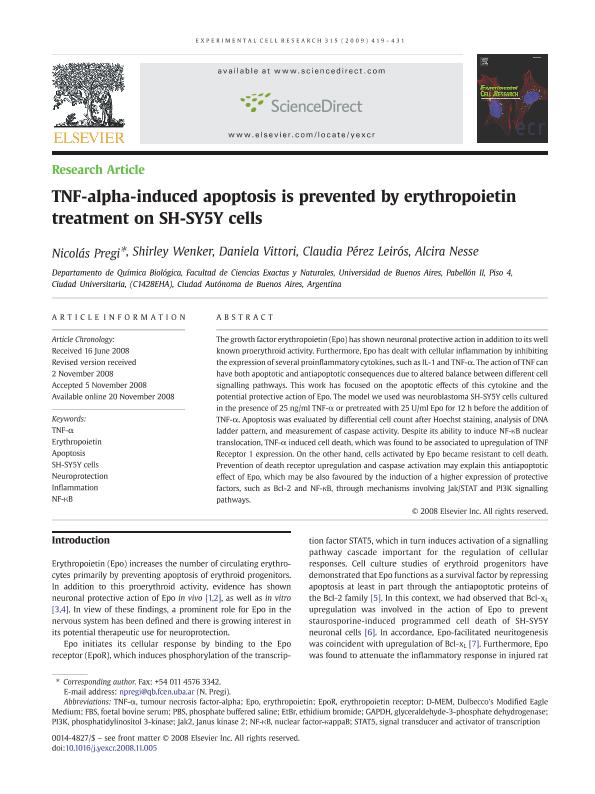Mostrar el registro sencillo del ítem
dc.contributor.author
Pregi, Nicolás

dc.contributor.author
Wenker, Shirley Denise

dc.contributor.author
Vittori, Daniela Cecilia

dc.contributor.author
Perez Leiros, Claudia

dc.contributor.author
Nesse, Alcira Beatriz

dc.date.available
2018-12-12T20:29:44Z
dc.date.issued
2009-02
dc.identifier.citation
Pregi, Nicolás; Wenker, Shirley Denise; Vittori, Daniela Cecilia; Perez Leiros, Claudia; Nesse, Alcira Beatriz; TNF-alpha-induced apoptosis is prevented by erythropoietin treatment on SH-SY5Y cells; Elsevier Inc; Experimental Cell Research; 315; 3; 2-2009; 419-431
dc.identifier.issn
0014-4827
dc.identifier.uri
http://hdl.handle.net/11336/66372
dc.description.abstract
The growth factor erythropoietin (Epo) has shown neuronal protective action in addition to its well known proerythroid activity. Furthermore, Epo has dealt with cellular inflammation by inhibiting the expression of several proinflammatory cytokines, such as IL-1 and TNF-α. The action of TNF can have both apoptotic and antiapoptotic consequences due to altered balance between different cell signalling pathways. This work has focused on the apoptotic effects of this cytokine and the potential protective action of Epo. The model we used was neuroblastoma SH-SY5Y cells cultured in the presence of 25 ng/ml TNF-α or pretreated with 25 U/ml Epo for 12 h before the addition of TNF-α. Apoptosis was evaluated by differential cell count after Hoechst staining, analysis of DNA ladder pattern, and measurement of caspase activity. Despite its ability to induce NF-κB nuclear translocation, TNF-α induced cell death, which was found to be associated to upregulation of TNF Receptor 1 expression. On the other hand, cells activated by Epo became resistant to cell death. Prevention of death receptor upregulation and caspase activation may explain this antiapoptotic effect of Epo, which may be also favoured by the induction of a higher expression of protective factors, such as Bcl-2 and NF-κB, through mechanisms involving Jak/STAT and PI3K signalling pathways. © 2008 Elsevier Inc. All rights reserved.
dc.format
application/pdf
dc.language.iso
eng
dc.publisher
Elsevier Inc

dc.rights
info:eu-repo/semantics/openAccess
dc.rights.uri
https://creativecommons.org/licenses/by-nc-sa/2.5/ar/
dc.subject
Apoptosis
dc.subject
Erythropoietin
dc.subject
Inflammation
dc.subject
Neuroprotection
dc.subject
Nf-ΚB
dc.subject
Sh-Sy5y Cells
dc.subject
Tnf-Α
dc.subject.classification
Otras Ciencias Biológicas

dc.subject.classification
Ciencias Biológicas

dc.subject.classification
CIENCIAS NATURALES Y EXACTAS

dc.title
TNF-alpha-induced apoptosis is prevented by erythropoietin treatment on SH-SY5Y cells
dc.type
info:eu-repo/semantics/article
dc.type
info:ar-repo/semantics/artículo
dc.type
info:eu-repo/semantics/publishedVersion
dc.date.updated
2018-11-22T15:30:41Z
dc.journal.volume
315
dc.journal.number
3
dc.journal.pagination
419-431
dc.journal.pais
Países Bajos

dc.journal.ciudad
Amsterdam
dc.description.fil
Fil: Pregi, Nicolás. Consejo Nacional de Investigaciones Científicas y Técnicas; Argentina. Universidad de Buenos Aires. Facultad de Ciencias Exactas y Naturales. Departamento de Química Biológica; Argentina
dc.description.fil
Fil: Wenker, Shirley Denise. Consejo Nacional de Investigaciones Científicas y Técnicas; Argentina. Universidad de Buenos Aires. Facultad de Ciencias Exactas y Naturales. Departamento de Química Biológica; Argentina
dc.description.fil
Fil: Vittori, Daniela Cecilia. Consejo Nacional de Investigaciones Científicas y Técnicas; Argentina. Universidad de Buenos Aires. Facultad de Ciencias Exactas y Naturales. Departamento de Química Biológica; Argentina
dc.description.fil
Fil: Perez Leiros, Claudia. Consejo Nacional de Investigaciones Científicas y Técnicas; Argentina. Universidad de Buenos Aires. Facultad de Ciencias Exactas y Naturales. Departamento de Química Biológica; Argentina
dc.description.fil
Fil: Nesse, Alcira Beatriz. Consejo Nacional de Investigaciones Científicas y Técnicas; Argentina. Universidad de Buenos Aires. Facultad de Ciencias Exactas y Naturales. Departamento de Química Biológica; Argentina
dc.journal.title
Experimental Cell Research

dc.relation.alternativeid
info:eu-repo/semantics/altIdentifier/url/http://www.sciencedirect.com/science/article/pii/S0014482708004692
dc.relation.alternativeid
info:eu-repo/semantics/altIdentifier/doi/https://doi.org/10.1016/j.yexcr.2008.11.005
Archivos asociados
